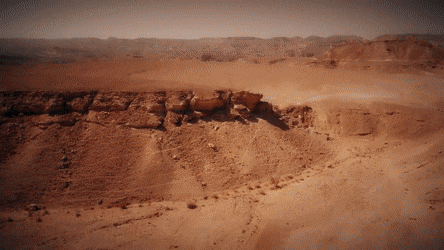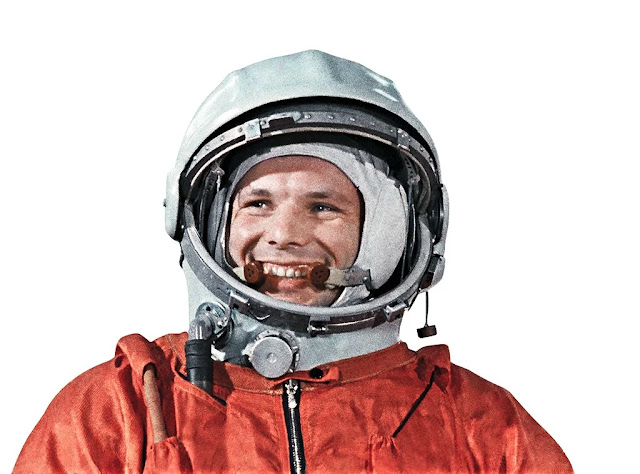Human Expansion in Space logo.
April 23, 2021
Preamble
Here the seventeenth (at the request of the author, this article is published before part 14) article of a series of articles by Ph.D. Morozov Sergey Lvovich, expert in chronology and calendar systems, as well as space biology and medicine, Parliamentarian of Asgardia (AMP) the first space Nation.
Ph.D. Morozov Sergey Lvovich
Space manned industrialization of the XXI century - the golden age of civilization
Image above: Yuri Alekseevich Gagarin, the founder of manned astronautics, the first cosmonaut of the planet Earth, made his historic flight into space on April 12, 1961. This is the date when civilization entered the Universe.
On April 12, 1961, on the Vostok spacecraft, the USSR pilot-cosmonaut Yuri Alekseevich Gagarin made the world's first flight into outer space.
The launch of the spacecraft took place from the Baikonur cosmodrome at 9 hours 7 minutes Moscow time (06:07:00 UTC). The ship, weighing 4730 kg, completed one revolution around the Earth in 108 minutes and landed at 10 hours 55 minutes (07:55:00 UTC) near the village of Smelovka, Saratov region.

Image above: Yuri Gagarin in the cockpit of the Vostok-1 spacecraft on April 12, 1961, 1 hour before launch. Checking the systems of the ship.
Krichevsky S.V., Ivanova L.V. The impact of the first manned flight into space on the development of Russia and humanity //
Aerospace sphere. - 2021. - No. 1. - P. 6 - 17. DOI: 10.30981 / 2587-7992-2020-106-1-6-17.
https://www.vesvks.ru/public/wysiwyg/files/%D0%9A%D1%80%D0%B8%D1%87%D0%B5%D0%B2%D1%81%D0%BA%D0%B8%D0%B9-%D0%98%D0%B2%D0%B0%D0%BD%D0%BE%D0%B2%D0%B0.pdf
Krichevsky S. It's time to master the Universe as a permanent place of residence. And not only to be proud of Gagarin's feat and celebrate the day of the first flight // Nezavisimaya gazeta. Application "SCIENCE". 13.04.2021 Krichevsky S.V. Humanization of the cosmos. It's time to master the Universe as a permanent residence. And not only to be proud of Gagarin's feat and celebrate the day of the first flight.
https://www.ng.ru/nauka/2021-04-13/14_8127_space.html
https://www.ng.ru/nauka/2021-04-13/14_8127_space.html

Image above: The world's first manned spacecraft "Vostok", which was launched on April 12, 1961, became the first spacecraft that made it possible to carry out a manned flight into outer space. Created by the leading designer O. G. Ivanovsky under the leadership of the general designer of OKB-1 S. P. Korolev (from 1958 to 1963).
Image above: Sergey Pavlovich Korolev (December 30, 1906 (January 12, 1907, - January 14, 1966).
Sergey Pavlovich Korolev is one of the main creators of world and Soviet rocket and space technology, a key figure in human space exploration, the founder of practical manned astronautics.
Under his leadership, the launch of the first artificial Earth satellite was organized and carried out on October 4, 1957, and the first cosmonaut of the planet, Yuri Gagarin, on April 12, 1961.
Image above: Sergey Pavlovich Korolev April 12, 1961 controls the launch of the Vostok-1 spacecraft with cosmonaut Yuri Alekseevich Gagarin.
Sergey Pavlovich Korolev is the "father" of space industrialization of the XXI century.

Image above: The Vostok-1 manned spacecraft, created by S.P. Korolev, on which cosmonaut Yuri Alekseevich Gagarin made the first ever space flight on April 12, 1961.
N. Armstrong (USA), - the first person to enter the lunar surface on July 20, 1969, - (from his speech at the first Starmus Science Festival in June 2011, dedicated to the 50th anniversary of the first human flight - USSR cosmonaut Yuri Alekseevich Gagarin - in space):
“The biggest challenge for us is to improve the human species. ... It is possible that in the future there will be a migration of people from the Earth both to natural planets and to artificial habitats. ... But if we want not only to survive, but to overcome all difficulties, we must continue to improve.
We must rise above our differences and become a true family of nations. We are proud of our heritage and our principles, and rightly so - they strengthen us, but they also bring us down. Based on our practice here on Earth, we are not yet qualified to populate and control a larger part of the universe than we do now.
We may or may not have enough time to grow as a species, to fully control our destiny. But there is still good reason for hope. And we have no other choice. Our instincts will undoubtedly push us to action".
S. Hawking (Great Britain, the world famous English theoretical physicist, cosmologist and astrophysicist, writer, director of research at the Center for Theoretical Cosmology at Cambridge University) (from speeches and publications 2006-2007, 2010): “the ultimate survival of mankind depends on colonization Solar system and beyond... Life on Earth is under increasing danger of being destroyed by a natural disaster such as a sudden global nuclear war, a genetically modified virus or other dangers that we have not yet thought about ”; "... humanity does not need to 'put all its eggs in one basket', and the only chance to survive in the long term is to subjugate the cosmos".

Image above: The launch of the Vostok spacecraft on April 12, 1961 with cosmonaut Yuri Alekseevich Gagarin on board.
The key role of artificial earth-level gravity on stationary and mobile Homeostatic arks (HA)
Civilization moves in its historical progressive development along a spiral (or steps) of socio-economic formations (OEF). There are 5 (five) of them:
1) primitive communal;
2) slaveholding;
3) feudal;
4) capitalist;
5) socialist (communist).
Currently, the Fifth OEF has completely exhausted itself. The transition to the Sixth CEF is inevitable. The earthly era of civilization is over. The cosmic era has begun. The idea of creating a space state of Asgardia, in particular, testifies to this (Ashurbeyli, I.R., 2016).
It will be an "astronautical" or "information-space" OEF. It begins with the total international industrialization of space (TMIK), specifically - with the industrialization of the Moon (Morozov, 2018, 2019, 2020).
The exploration of the Moon, Mars and other space objects has the same main problem - the creation of artificial conditions for permanent comfortable living of people. This was also recognized by Elon Musk, who considers this issue to be the main problem of the colonization of Mars. Therefore, the development and construction of stationary GCs (Homeostatic Arks) equipped with earth-level artificial gravity systems on the planets of the solar system has no alternative.
“I think that going to Mars is not a fundamental issue. The fundamental question is building a base, a self-sufficient city on Mars. I want to emphasize that this is a very difficult and dangerous task not for the faint of heart. Chances are good that someone will die, there will be many difficulties, but it will be great if everything works out", Musk said.

Image above: “I think that going to Mars is not a fundamental issue. The fundamental question is the construction of a base, a self-sufficient city on Mars"- (Elon Musk).
Mars, in our opinion, should become an oasis of prosperity for civilization in the space desert, similar to our beautiful Earth today. This is a difficult task that today needs to be solved by simulating the construction of a full-fledged base, first on Earth and on the Moon in the first place, and then to implement it on Mars itself. Here Elon Musk is absolutely right.
From the birth of the first person on a stationary GC on the Moon in conditions of artificial gravity of the earth's level, the "cosmic" humanity will probably begin its countdown (Krichevsky S.V., 2020).
Home for the first space man, most likely, will be the Moon, not the Earth? It may be on the Moon that it will be most convenient to deploy mass design, production and construction of mobile GCs (planets and starships equipped with earth-level artificial gravity systems), on which civilization will conquer the Universe (Morozov, 2018).
The exploration of Mars and other objects of the solar system will begin with the exploration of the moon. The wealth and power of civilization will grow by the Moon.
"For humanity, the Moon is first of all the seventh continent of the Earth. We can say that she, like Eve, was created from the rib of Adam-Earth. The Moon, as a real wife, plays a serious role in the life of the Earth, starting with the great tides, and ending with the fact that it saves us by pulling back a lot of meteor impacts The moon needs to be explored simply as part of the Earth.

Image above: Ice traps in craters near the Moon's South Pole. The four areas circled in white are the coldest places with average annual surface temperatures of minus 220-250 degrees Celsius. Their diameter is about 50 kilometers. Trapped near the South Pole - up to ten billion tons of ice.
Water reserves have been found on the Moon under the surface of the polar regions. In the form of such permafrost. It is difficult to say how deeply these reserves are spread, how large they are, as our institute is engaged in this. Therefore, the polar regions of the Moon are more promising and interesting for us today.
The development will begin precisely from the polar regions. These will be rotational expeditions, as oilmen work now.

Image above: © Photo: NASA / Goddard Space Flight Center / DLR / ASU; Overlay: M. Elvis, A. Krosilowski, T. Milligan Potential sites for cosmological telescopes in craters on the far side of the Moon. On the right - the scale of heights.
Scientists naturally think about the development of science, about the creation of a lunar astrophysical observatory. The moon now presents unique opportunities for radio astronomy. Near the Earth, everything is filled with radio noise, radio spam from millions of radio stations, mobile phones, so the best place for radio astronomers is the Moon, and even better is its reverse side, which is generally ideally protected from this earthly noise".

Image above: Scientific Director of the Space Research Institute of the Russian Academy of Sciences, Academician Lev Zelyoniy.
Lev Zelyoniy, scientific director of the Space Research Institute of the Russian Academy of Sciences, is a friend of Jimmy Green, NASA's planetary leader. They have known him since the 1970s. In parallel, they made a career in space science, and now they often meet. Recently, almost at the same time, Lev Zelyony became the scientific director of the IKI Institute of the Russian Academy of Sciences, and Jim Green became the chief scientist of NASA.
"The Moon presents unique opportunities for radio astronomy. Near the Earth, everything is filled with radio noise, radio spam from millions of radio stations, mobile phones, so the best place for radio astronomers is the Moon, and even better is its reverse side, which is generally ideally protected from this earthly noise. A special a group to create an electromagnetic reserve there".
“The moon was at first much closer to Earth than it is today - 80,000 miles compared to 238,000 miles today. The gravity of the newly formed moon helped stabilize the rotation of the Earth, which at that time made a full revolution in about five hours. The moon slowed it down to the 24 hours we know today.
Jim Green, NASA's chief scientist and lead author of the new study, said: “The moon appears to represent a significant protective barrier from solar wind for the Earth, which was critical to the Earth's ability to maintain its atmosphere. New research has shown that the newly formed Moon could have protected Earth - which did not yet have an atmosphere - from deadly solar flares".

Image above: Jim Green has been NASA Chief Scientist beginning May 1, 2018. Credits: NASA. National Aeronautics and Space Administration Page Last Updated: Apr 10, 2019 Page Editor: Ron Mochinski NASA Official: Brian Dunbar.
It would be correct from the very beginning of the exploration of the Moon to prohibit any industrial infrastructure on its reverse side, so that it would be possible to calmly carry out only scientific work and listen to the electromagnetic noise of the Universe. "
“The Moon allows assembling, among other things, huge radio telescopes - the installations are very massive and heavy, it is difficult to assemble them in orbit, but on the Moon it can be done gradually.
First, build a setup with one sensitivity, then add equipment, build up mass and get a new, higher sensitivity, and so on. In this way, very good results can be achieved, which are difficult, if not impossible, to achieve in orbit".
("Scientific Director of the Institute of Space Research of the Russian Academy of Sciences Lev Zelyoniy on when we will fly to the moon and why". https://zen.yandex.ru/media/belrus/nauchnyi-rukovoditel-instituta-kosmicheskih-issledovanii-ran-lev-zelenyi-o-tom-kogda-my-poletim-na-lunu-i-zachem-607362a16e6b477f16609a47).

Image above: Morozov Sergey Lvovich. Candidate of Medical Sciences. (The power, might and wealth of civilization will grow with the Moon).
Next article, Part 17.3: "Colonization of the Moon - the source of the power, wealth and power of civilization in the Universe, - the strategic "engine" of space industrialization of the XXI century"
Related articles:
Exodus of civilization into space - Humanity's strategy to create stationary and mobile Homeostatic arks. Part 17.1
https://orbiterchspacenews.blogspot.com/2021/04/exodus-of-civilization-into-space_21.html
Exodus of civilization into space - Tsiolkovsky Galactic State. Part 9
https://orbiterchspacenews.blogspot.com/2021/04/exodus-of-civilization-into-space_19.html
Exodus of civilization into space - Symbol of the End of the XXI century. Part 8
https://orbiterchspacenews.blogspot.com/2021/04/exodus-of-civilization-into-space_16.html
Exodus of civilization into space - Stopping the process of increasing value added. Part 7
https://orbiterchspacenews.blogspot.com/2021/04/exodus-of-civilization-into-space_14.html
Exodus of civilization into space - The sixth socio-economic formation of civilization. Part 6
https://orbiterchspacenews.blogspot.com/2021/04/exodus-of-civilization-into-space-sixth.html
Exodus of civilization into space - Space man. Part 5
https://orbiterchspacenews.blogspot.com/2021/04/exodus-of-civilization-into-space-space.html
Exodus of civilization into space - Biological End of the World. Part 4
https://orbiterchspacenews.blogspot.com/2021/04/exodus-of-civilization-into-space_7.html
Exodus of civilization into space - Geochronological Ice Ages, periods, eras. Part 3
https://orbiterchspacenews.blogspot.com/2021/04/exodus-of-civilization-into-space_5.html
Exodus of civilization into space - Astrophysical End of the World. Part 2
https://orbiterchspacenews.blogspot.com/2021/04/exodus-of-civilization-into-space.html
The ideology of space expansion - Space calendar. Part 1
https://orbiterchspacenews.blogspot.com/2021/03/the-ideology-of-space-expansion-space.html
Related links:
About Ph.D. Morozov Sergey Lvovich: https://zen.yandex.ru/media/id/5fbb90753e3ad265054f930a/ob-avtore-kanala-5fbd2bf80b4af80149fb12c2
Original article in Russian on Zen.Yandex:
https://zen.yandex.ru/media/id/5fbb90753e3ad265054f930a/ishod-civilizacii-v-kosmos-chast-17-strategiia-chelovechestva-po-sozdaniiu-stacionarnyh-i-mobilnyh-gomeostaticheskih-kovchegov-606467c1fa23f523d376a218
Asgardia website: https://asgardia.space/
Author: Ph.D. Morozov Sergey Lvovich / Zen.Yandex. Editor / Translation: Roland Berga.
Greetings, Orbiter.ch














































